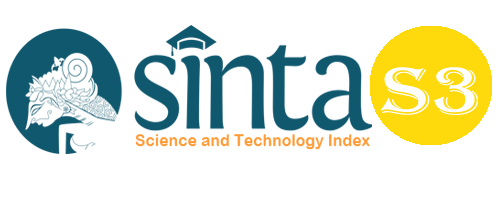Teaching Morality with Acehnese Idioms in Indonesia
Abstract
Every society has its local pearls of wisdom in educating its generations. In the western part of Indonesia, Acehnese society frequently uses figurative language, like idioms, as a tool for teaching morality to their generations. Even though research on local society's use of local wisdom to educate their generations has existed, research on the use of idioms in the Acehnese language is scant. This study investigated whether idioms in the Acehnese language contain educational values. In doing so, this study used interviews to collect data and involved 14 respondents from seven districts in Aceh that use a similar dialect of the Acehnese language, including Aceh Utara, Aceh Timur, Lhokseumawe, Bireuen, Aceh Besar, Pidie, and Banda Aceh. The results showed ten hand-related idiomatic expressions in the Acehnese language fall into pure idioms and semi-literal idioms. The idioms are used to teach moral values, such as encouragement to work, hardworking, responsibility, diligence, creativity, and many more. In conclusion, there is a nexus between the Acehnese hand-related idioms in the Acehnese society in Indonesia and the educational values they embrace.
Keywords
Full Text:
PDFReferences
Al-Kadi, A. (2015). Towards idiomatic competence of Yemeni EFL undergraduates. Journal of Language Teaching and Research, 6(3), 513–523.
Al-Mohizea, M. I. (2017). The comprehension of body-part idioms by EFL learners: A cognitive linguistics-inspired approach. Journal of Cognitive Science, 18(2), 175-200.
Alhaysony, M. H. (2017). Strategies and difficulties of understanding English idioms: A case study of Saudi University EFL students. International Journal of English Linguistics, 7(3), 70-84.
Ayed, S. (2008). Avoidance of idioms: An ethnic group identity issue? [Unpublished MA thesis]. Concordia University.
Baker, M. (2001). In other words: A coursebook on translation. London: Routledge.
Bataineh, M. T., & Al-Shaikhli, K. A. (2020). Cultures Think Alike and Unlike: A Cognitive Study of Arabic and English Body Parts Idioms. Multicultural Education, 6(5).
Bortfeld, H. (2003). Comprehending idioms cross-linguistically. Experimental Psychology, 50(3), 217-230. http://dx.doi.org/10.1026//1617-3169.50.3.217
Cooper, T. C. (1999). Processing of idioms by L2 learners of English. TESOL Quarterly, 33(2), 233–262. https://doi. org/10.2307/3587719
Croft, W., & Cruse, D. A. (2004). Cognitive linguistics. Cambridge: Cambridge University Press.
Erman, B., & Warren, B. (2000). The idiom principle and the open choice principle. Text & Talk, 20(1), 29–62. https://doi.org/10.1515/text.1.2000.20.1.29
Fernando, C. (1996). Idioms and idiomaticity. Oxford: Oxford University Press.
Feronica, L., & Simbolon, L. (2017). Idiomatic expression in Acehnese wedding ceremony. International Journal of Linguistics, 9(3), 137-151.
Gibbs Jr, R. W. (2005). Embodiment and cognitive science. Cambridge University Press.
Gibbs, R.W., Bogdanovich, J.M., Sykes, J.R. and Barr, D.J. (1997). Metaphor in idiom comprehension. Journal of Memory and Language, 37(2), 141-154.
Gramley, S., & Pátzold, M. (2003). A survey of modern English. London: Routledge.
Ibrahim, I. H., & Usman, J. (2021). Cultural Values in Acehnese Farming-Related Proverbs. Indonesian Journal of Applied Linguistics, 11(2), 363-370.
Johnson, M., & Lakoff, G. (1980). Metaphors we live by. Chicago: University of Chicago Press.
Kemertelidze, N., & Giorgadze, M. (2020). One Approach to Idioms and Their Peculiarities in the English Language. European Scientific Journal, 16(11), 13-28.
Khan, O., & Can Daşkin, N. C. (2014). “You reap what you sow” idioms in materials designed by EFL teacher-trainees. Novitas-ROYAL (Research on Youth and Language), 8(2), 97–118.
Khonbi, Z., & Sadeghi, K. (2017). Improving English language learners’ idiomatic competence: Does mode of teaching play a role?. Iranian Journal of Language Teaching Research, 5(3), 61-79.
Kloos, D., & Samuels, A. (2019). Religious Idioms of Vulnerability. Inside Indonesia, 136.
Kövecses, Z. (2001). A cognitive linguistic view of learning idioms in an FLT context. Applied Cognitive Linguistics, 2, 87-115.
Kövecses, Z. (2001). A cognitive linguistic view of learning idioms in an FLT context. In M. Pütz, S. Niemeier, & R. Dirven, Language pedagogy (pp. 87-115). Berlin: Mouton de Gruyter.
Kovecses, Z. (2004). Metaphor and emotion: Language, culture and body in human feeling. Cambridge University Press.
Kovecses, Z., & Szabo, P. (1996). Idioms: A view from cognitive semantics. Applied Linguistics, 17(1), 326-355.
Lakoff, G. (1987). Women, fire, and dangerous things: What categories reveal about the mind. Chicago: University of Chicago press.
Landau, M. J., Robinson, M.D., & Meier, B.P. (2014). Introduction. In Mark J. Landau, Michael D. Robinson, and Brian P. Meier. The power of metaphor: Examining its influence on social life (pp. 3-16). American Psychological Association.
Liontas, J. I. (1999). Developing a pragmatic methodology of idiomaticity: The comprehension and interpretation of SL vivid phrasal idioms during reading (Unpublished doctoral dissertation). The University of Arizona, Tucson, AZ.
Littlemore, J., & Low, G. (2006). Figurative thinking and foreign language learning. Palgrave Macmillan.
Maltese, A., Scifo, L., Fratantonio, A., & Pepi, A. (2012). Linguistic prosody and comprehension of idioms and proverbs in subjects of school age. Procedia-Social and Behavioral Sciences, 69, 2027-2035.
Muliawati, I., Ismail, N. M., & Zalha, F. B. (2019). Acehnese adolescents’ awareness of Acehnese idiom and simile. Studies in English Language and Education, 6(2), 319-332.
Nation, P., & Meara, P. (2002). Vocabulary. In N. Schmitt (Ed.), An introduction to applied linguistics (pp. 35–54). Arnold.
O'Dell, F., & McCarthy, M. (2010). English idioms in use (advanced). Cambridge: Cambridge University Press.
Orfan, S. N. (2020). Afghan EFL students’ difficulties and strategies in learning and understanding English idioms. Cogent Arts & Humanities, 7(1), 1796228.
Rafiki, A., & Wahab, K. A. (2014). Islamic values and principles in the organization: A review of literature. Asian Social Science, 10(9), 1-7.
Rehan, F., Block, J., & Fisch, C. (2019). Entrepreneurship in Islamic communities: How do Islamic values and Islamic practices influence entrepreneurship intentions?. Journal of Enterprising Communities: People and Places in the Global Economy, 13(5), 557–583.
Sinclair, J. (1991). Corpus, concordance, collocation. Oxford: Oxford University Press.
Sofa, E. M. (2018). Islamic values in higher education students’ communication in Edmodo learning platform. Edukasia Islamika, 3(1), 50-65.
Sulaiman, B. (1979). Bahasa Aceh. Banda Aceh: Firma Faraby.
Ta'amneh, M. A. A. A. (2021). Strategies and Difficulties of Learning English Idioms Among University Students. Journal of Education and Practice, 12(23).
Usman, J. & Yusuf, Y. Q. (2020). The dehumanizing metaphors in the culture of Acehnese in Indonesia. Indonesian Journal of Applied Linguistics, 10(2), 397-405. https://doi.org/10.17509/ijal.v10i2.28611
Wongthai, N. (2015). The meaning extensions of human body part terms in Thai idioms. Asian Social Science, 11(9), 146.
Yu-Hua, C., & Wang, L. (2016). Opening pandora's box: A corpus-based study of idioms in ELT materials. Journal of Asia TEFL, 13(4), 381-390.
DOI: https://doi.org/10.33258/birci.v5i2.5066
Article Metrics
Abstract view : 55 timesPDF - 27 times
Refbacks
- There are currently no refbacks.

This work is licensed under a Creative Commons Attribution-ShareAlike 4.0 International License.

This work is licensed under a Creative Commons Attribution-ShareAlike 4.0 International License.

_.gif)

















_.gif)



